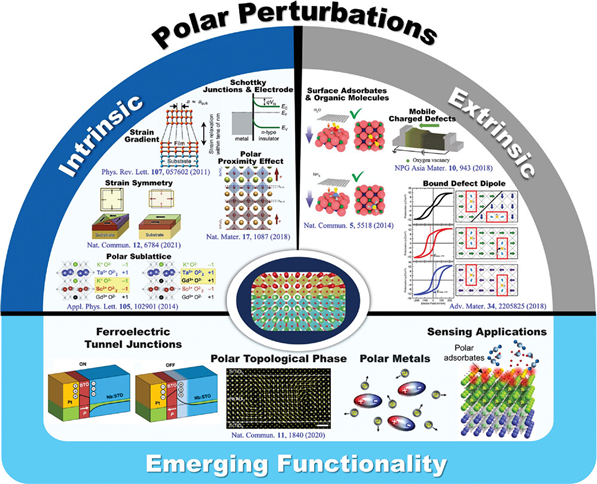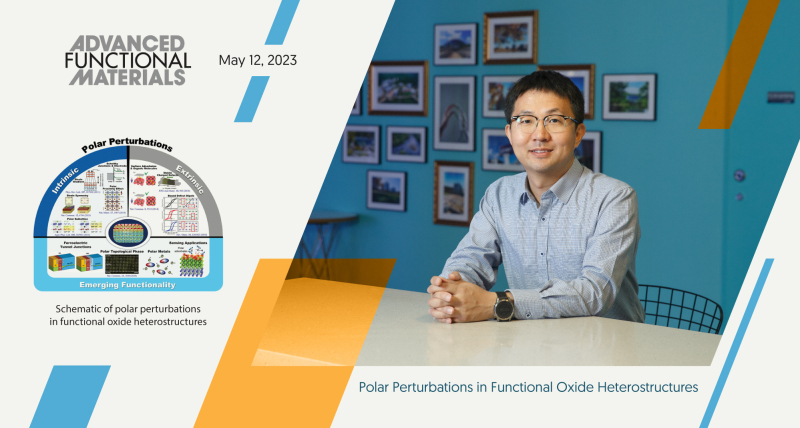Thin film heterostructures are a type of material where two or more materials are bonded in a thin film form. Due to their excellent ability to combine multiple materials through interfacial bonding, they have gained attention as a significant material technology capable of expressing new ground states of the material and implementing high-performance and highly efficient multifunctional devices.
A research team jointly led by Professor Yoon Seok Oh (Department of Physics, UNIST), Professor Tae Heon Kim (University of Ulsan), Professor Lingfei Wang (University of Science and Technology of China), Professor Hyungwoo Lee (Ajou University), and Professor Woo Seok Choi (Sungkyunkwan University) suggested that polar perturbations are essential control variables for realizing new functions in oxide heterogeneous thin film structures.
Point-contact transistors, the first transistors invented by John Bardeen, Walter Brattiain, and William Shockley who won the Nobel Prize in Physics in 1956, have advantages such as small size, low heat generation, and low power consumption compared to vacuum tubes. However, with the development of metal-oxide-semiconductor field-effect transistors (MOSFET) that use oxide thin films, smaller transistor devices were introduced and industrialization became possible.

Figure 1. Schematic of polar perturbations in functional oxide heterostructures. The physical properties of complex oxides are significantly influenced by various factors with intrinsic or extrinsic polar characteristics, enabling the realization of emerging functionalities in oxide thin-film heterostructures through precise control of these perturbations. This figure has been reproduced with permission from several sources and is intended to highlight how polar perturbations can be used to achieve highly tunable functional properties in complex oxide heterostructures.
The oxide thin film heterostructure, a major component of MOSFET, is being researched and developed worldwide due to its unique functional characteristics and interesting solid-state physics properties that appear in thin films. In particular, epitaxial oxide thin film heterostructures comprising different complex oxides possess a crystallographically well-aligned lattice structure that expresses hidden new ground states due to strong correlation between electrons in transition metal oxides. This structure can serve as the next-generation platform for designing and implementing new functional semiconductors and quantum materials while improving the functionality of synthesized thin film materials and devices.
The oxide thin film heterostructure, a major component of MOSFET, is being researched and developed worldwide due to its unique functional characteristics and interesting solid-state physics properties that appear in thin films. In particular, epitaxial oxide thin film heterostructures comprising different complex oxides possess a crystallographically well-aligned lattice structure that expresses hidden new ground states due to strong correlation between electrons in transition metal oxides. This structure can serve as the next-generation platform for designing and implementing new functional semiconductors and quantum materials while improving the functionality of synthesized thin film materials and devices.
In this paper, the joint research team presents various polar perturbation factors in Thin Film Heterostructure as elements that can further enhance the multifunctionality of oxide Thin Film Heterostructure. These polar perturbation factors are divided into essential factors formed during manufacturing of thin films and external factors that can be reversibly controlled. The paper systematically summarizes how these essential and external polar perturbation factors can be applied to improve the functionality of nano-scale oxide thin-film heterostructures along with internal physical mechanisms.
The study findings have been published ahead of their official publication in the online version of the Advanced Functional Materials on May 12, 2023
Journal Reference
Yoon Seok Oh, Lingfei Wang, Hyungwoo Lee, et al., “Polar Perturbations in Functional Oxide Heterostructures,” Adv. Funct. Mater., (2023).













